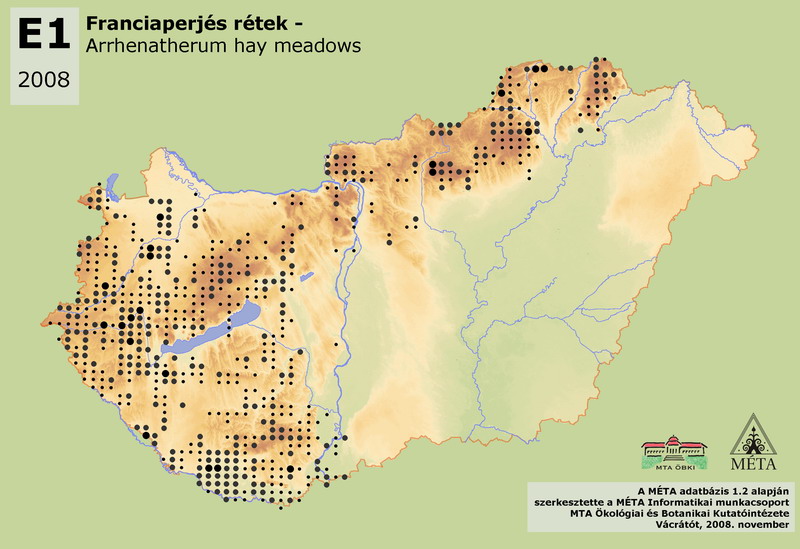MÉTA Program >>> Habitat distribution maps


E1 – Arrhenatherum hay meadows:
Mesic meadows of nutrient rich soils developed in areas of colline and submontane valleys, terraces, basins, high floodplains. The dominant tall grass species of the habitat (Arrhenatherum elatius, Dactylis glomerata, Phleum pratense, Holcus lanatus, Trisetum flavescens, Poa pratensis) are completed by a legion of flowering meadow species. The total actual area in Hungary is approximately 20000 ha. The half of it can be found in the humid, mainly hilly part of Dunántúl (Nyugat-Dunántúl 5300 ha, Dunántúli-dombság 4600 ha). It covers also large areas in the Északi-középhegység (4000 ha). The humid parts of Alföld, mainly the edges of that (3000 ha), like areas along Dráva River, offer adequate environment for the habitat. Similarly, these hay meadows occur mainly in the (more humid) southern part of Kisalföld (1500 ha), and in the relatively rainy parts of the Dunántúli-középhegység (1300 ha). In the past, hay meadows were formed at fringes, openings and clearings of mesic forests, and were used and maintained by mowing. The gradual abandonment of the traditional management leads to the reduction of the area of this habitat. On the other hand, partly this habitat develops from drying mesotrophic wet meadows. The identification of Arrhenatherum hay meadows (E1) is difficult towards the transitional stands of uncharacteristic meadows, grasslands and tall herb communities (OB, OC), mesotrophic wet meadows (D34) and other hay meadows (E2).
Molnár, Zs., M. Biró, J. Bölöni & F. Horváth (2008): Distribution of the (semi-)natural habitats in Hungary I.: Marshes and grasslands, Acta Botanica Hungarica 50 (Suppl): 59-105. >>> letöltés (5,4 MB, PDF)
MÉTA Program,
MÉTA Fotótár
MÉTA Élőhely-Ismereti Útmutató (ÉIÚ),
MÉTA Adatlap-Kitöltési Útmutató (AL-KÚ)
(C) MÉTA Informatika, 2005-2009,
MTA Ökológiai és Botanikai Kutatóintézete